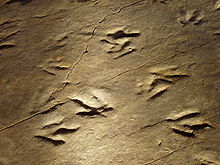Eubrontes
| Eubrontes | |
|---|---|
 |
|
| Trace fossil classification | |
| Ichnoclass: | Reptilipedia |
| Ichnocohort: | Theropodipedia |
| Ichnoorder: | †Neotetanuripedidii |
| Ichnofamily: | †Eubrontidae |
| Ichnogenus: |
†Eubrontes Hitchcock, 1845 |
| Type ichnospecies | |
|
E. giganteus (Hitchcock, 1836) |
|
| Ichnospecies | |
|
|
Eubrontes (Hitchcock, 1845) is the name of fossilised dinosaur footprints dating from the Late Triassic and Early Jurassic. They have been identified from France, Poland, Slovakia, Italy, Spain, Sweden, Australia (Queensland) and the USA. It is a junior synonym of Grallator.
Eubrontes is the name of the footprints, identified by their shape, and not of the genus or genera that made them, which is as yet unknown. They are most famous for their discovery in the Connecticut River Valley of Massachusetts in the early 19th century. They, among other footprints, were the first known dinosaur tracks to be discovered in North America, though they were initially thought to have been made by large birds.
The footprints were first described by Edward Hitchcock, a professor of Amherst College, who thought they were made by a large bird. He originally assigned them to ichnotaxon Ornithichnites in 1836, then Ornithoidichnites in 1841, before coining Eubrontes in 1845. The name means "true thunder," probably referring to the supposed weight of the animal impacting on the ground.
in 1858 Hitchcock still described the tracks as those of "a thick-toed bird," since there was no evidence of tail drag marks. But by the time that Richard Swann Lull began working on the tracks in 1904, they were thought to belong to a dinosaur. Lull originally thought they were from a herbivore, but by 1953 he concluded they were from a carnivorous theropod. Many later authors have agreed with this interpretation, but some have suggested that they are from a prosauropod. Regardless, they are almost certainly saurischian.
A typical Eubrontes print is from 25–50 cm long, with three toes that terminate in sharp claws. It belongs to a biped that must have been over one metre high at the hip and from 5–6 metres long. In the 1960s Edwin Colbert and others supposed that a large heavy carnivore like Teratosaurus (then considered to be a dinosaur) made the track, but a possible candidate is Dilophosaurus, a large theropod related to Coelophysis, or a close relative such as Podokesaurus. However no Dilophosaurus fossil material is associated with Eubrontes tracks. The tracks may also be from a plateosaurid.
...
Wikipedia
